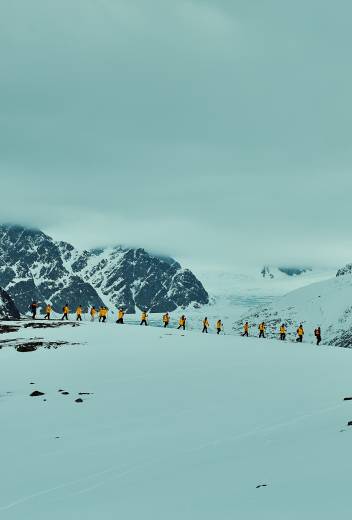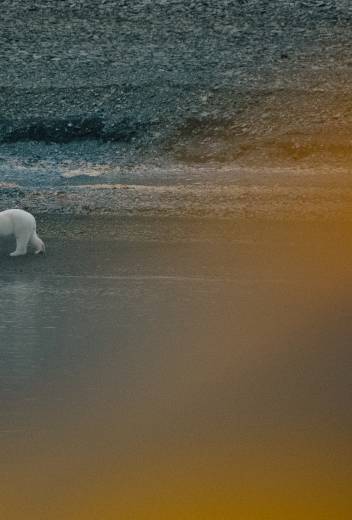Iceland and Greenland are two of the most fascinating islands on the face of the Earth. Travelers from around the world are seduced by the mystery that surrounds both islands due to their northern locations, frozen landscapes, and the natural beauty that captivates explorers from around the world.
Due to their proximity to the Arctic Circle, both Iceland and Greenland are surrounded by icebergs and glaciers that provide photographic opportunities for creative adventurers. Both islands are also home to impressive wildlife, including the elusive Arctic Fox that roams across the shores of Iceland, and the whales and polars in Greenland. This only adds to the excitement and wonder associated of the two northerly destinations.
Icebergs are incredible sights to behold, especially on the northern shores of the Arctic Ocean. Where exactly can you see icebergs in and around Iceland and Greenland? That’s what we’ll look into in this helpful guide.
Where do icebergs come from?
According to National Geographic, icebergs are formed when they break away from larger glaciers through a process known as “calving.” They contain only frozen freshwater and no saltwater as salt is prone to melt ice into water. Most icebergs are created from glaciers that form along the coasts of Greenland, Iceland, and even parts of northern Canada, Alaska, Russia, and the Scandinavian countries.

Icebergs, as illustrated in this towering ice sculpture floating in the blue-hued Arctic waters, are sighted in various parts
of Greenland. Photo: Aningaaq R. Carlsen/Visit Greenland
The water from the ocean also flows against the bottom of the icebergs, slowly melting at the base of the icy structure. Over time, as the water warms due to rising temperatures, the base of the iceberg will melt at a faster pace, potentially causing the entire iceberg to dissolve into the water. However, as winter approaches and temperatures remain at or below freezing, the icebergs regain their structural integrity, surviving for another winter.
Where are icebergs located?
As stated, many icebergs in the northern hemisphere originate in and around Iceland and Greenland. Areas along the northern coasts of Canada and Europe can also contribute to the iceberg masses floating in the ocean, depending on the time of year and the amount of accumulated precipitation in those regions.
In the southern hemisphere, almost all icebergs are formed by breaking away from the landmass of Antarctica. Since this is the world’s largest body of frozen land, it’s common for icebergs and glaciers to break off from mainland Antarctica and float through the Southern Ocean.
Icebergs in Iceland
In order to witness icebergs in and around Iceland, you’ll want to book a passage on the incredible Under The Northern Lights: Exploring Iceland and East Greenland adventure. This is an amazing 14-day expedition that departs from Reykjavik, Iceland, and heads due north across the Arctic Circle towards Greenland.
Both Iceland and Greenland are beautiful rugged islands with plenty of wildlife to observe, more so in Greenland perhaps. In Greenland, you’ll find yourself immersed in the untapped beauty of the rugged Arctic and likely encounter communities of Inuit. Among the tourist highlights you’ll get to witness include the community of Ittoqqortoormiit, the ancient ruins of Thule, and the massive icebergs that float around the islands.
You’ll also have the opportunity to book exciting excursions during your polar adventure, including Zodiac cruising. From these sturdy rafts, you’ll witness massive icebergs floating in the ocean and perhaps spot whales, seabirds, and other marine animals in their natural habitats. Experienced adventurers have identified the summer months of June through August as the peak opportunity to witness whales in and around Iceland.

Guests of Quark Expeditions enjoy a close-up view (within a safe distance) of an iceberg while on a Zodiac cruise. Such ice formations can be seen in various parts of Iceland and Greenland. Photo: Courtesy Quark Expeditions
Icebergs in Greenland
When it comes to seeing icebergs in Greenland, the best opportunity to do so is by sailing aboard the Essential Greenland: Southern Coasts and Disko Bay adventure. This is a 15-day voyage that allows you to explore almost the entire southern coast of Greenland along the cusp of the Arctic Circle.
You’ll come across many destinations adventurers long to visit in Greenland, including the communities of Skjoldungen, Uunartoq, Paamiut, Nuuk, Itilleq, Sisimiut, Ilulissat, and Kangerlussuaq. You’ll immerse yourself in local cultures and witness both icy and green landscapes untouched since the days of early explorers.
Guests on the “Essential Greenland” voyage can book a paddling excursions and perhaps view icebergs near the shores of Prins Christian Sund and capture memorable photographs from a unique vantage point.
Where to see icebergs in Iceland and Greenland
One of the best ways to see icebergs in Iceland and Greenland is to follow the advice of your experienced guides who will highlight the best destinations for those opportunities. For example, the Ilulissat Icefjord is a UNESCO World Heritage Site that’s home to the world’s most productive glacier in the northern hemisphere, Jakobshavn Glacier.
This is a great place to enjoy a Zodiac excursion to experience icebergs from a unique perspective that you won’t have on land. You’ll also have the option to travel ashore into the nearby town of Ilulissat, which actually translates into “iceberg.” From Ilulissat, you’ll be able to set up your camera and capture the beauty of enormous icebergs that float out into the Disko Bay off the coast of the island.









